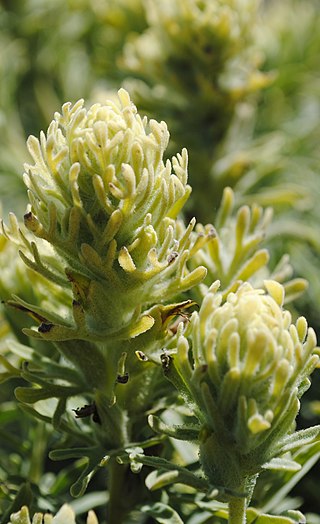
The Tiburon paintbrush or Tiburon Indian paintbrush is an endangered taxon of flowering plant in the family Orobanchaceae. It is endemic to the San Francisco Bay Area in California in the United States, where it occurs in Marin, Napa, and Santa Clara Counties.

Castilleja exserta is a species of plant in the genus Castilleja which includes the Indian paintbrushes. Its common names include purple owl's clover, escobita, and exserted Indian paintbrush.

Castilleja angustifolia is a species of wildflower known by the common names northwestern Indian paintbrush and desert Indian paintbrush. It is an herbaceous perennial native to the desert, scrublands, and woodlands of western North America. It grows in hot sandy soils and rock crevices in dry conditions.

Castilleja rubicundula is a species of Indian paintbrush known by the common name cream sacs. It is native to northern California and southwestern Oregon. It is found in coastal and inland grasslands.

Chloropyron maritimum is a rare species of flowering plant in the family Orobanchaceae native to western North America. It is known by the common names saltmarsh bird's beak and Point Reyes bird's beak, depending on the specific subspecies.

Castilleja linariifolia is a perennial plant, native to the United States and is the state flower of Wyoming. It has a number of common names including Wyoming Indian paintbrush, narrow-leaved Indian paintbrush, desert paintbrush, Wyoming desert paintbrush, Wyoming paintbrush, linaria-leaved Indian Paintbrush, and Indian paintbrush.

Castilleja ambigua is a species of Indian paintbrush known by the common name Johnny-nip. It is native to western North America from British Columbia to California, where it is most common along the coast in salt marshes and scrub.

Castilleja densiflora is a herbaceous flowering plant species known by the common names denseflower Indian paintbrush or white / denseflower owlclover. Like other members of the Indian paintbrushes, it is a root-parasite. It is native to California and northern Baja California, where it grows in grassland and chaparral habitat. It is a variable species. It is generally 10 to 40 centimeters tall with linear or lance-shaped leaves up to 8 centimeters long, and with or without lobes. The inflorescence is as small as 3 centimeters or as long as 25 centimeters in length, and has bracts tipped in white to dull or bright pink or purple. Between the bracts appear the flowers, which are somewhat rounded and pouched, and white to yellow to pink or purple in color.

Castilleja grisea is a rare species of Indian paintbrush known by the common name San Clemente Island Indian paintbrush. It is endemic to San Clemente Island, one of the Channel Islands of California. San Clemente Island is owned by the US Navy so the Navy is involved in a management program to recover this species.
Castilleja lasiorhyncha is a species of Indian paintbrush is endemic to southern California known by the common name San Bernardino Mountains Indian paintbrush. Most of the plant's range is in the San Bernardino Mountains, where it grows in forests and meadows.

Castilleja lemmonii is a species of Indian paintbrush known by the common name Lemmon's Indian paintbrush or meadow paintbrush.

Castilleja lineariiloba is a species of Indian paintbrush known by the common name sagebrush Indian paintbrush that is endemic to the grasslands of the Sierra Nevada foothills in California.

Castilleja miniata is a species of Indian paintbrush known by the common name giant red Indian paintbrush. It is native to western North America from Alaska to Ontario to California to New Mexico, where it grows usually in moist places in a wide variety of habitat types.

Castilleja parviflora is a species of Indian paintbrush known by the common name mountain Indian paintbrush. It is native to western North America from Alaska to California, where it grows in high mountain habitat, including areas of alpine climate.
Castilleja praeterita is a species of Indian paintbrush known by the common name Salmon Creek Indian paintbrush. It is endemic to the High Sierra Nevada of California, where it grows in dry sagebrush meadows.

Castilleja subinclusa is a species of Indian paintbrush known by the common names longleaf Indian paintbrush and Franciscan paint brush.

Castilleja septentrionalis is a species of Indian paintbrush known by several common names, including northern paintbrush, sulfur paintbrush, and pale painted cup. There is taxonomic disagreement as to if it is one species widely distributed in mountain and alpine environments of North America or if there is a second species, Castilleja sulphurea, in the Rocky Mountains.

Castilleja coccinea, commonly known as scarlet Indian paintbrush or scarlet painted-cup, is a biennial flowering plant in the Orobanchaceae (broomrape) family. It is usually found in prairies, rocky glades, moist and open woodlands, thickets, and along streams in central and eastern North America.

Castilleja integra, with the common names orange paintbrush, Southwestern paintbrush, and wholeleaf paintbrush, is a partially parasitic herbaceous perennial plant native to the Southwestern United States and Northern Mexico. The species produces a relatively large amount of nectar and is attractive to hummingbirds. It is better suited to cultivation than most other species in the paintbrush genus (Castilleja) and is therefor used in xeriscape gardens and naturalistic meadows, even outside its native range.

Castilleja hispida is a species of flowering plant in the family Orobanchaceae, also known by the common name harsh paintbrush, or harsh Indian paintbrush. It is native to British Columbia, Alberta, Washington, Idaho, Montana, and Oregon.



















